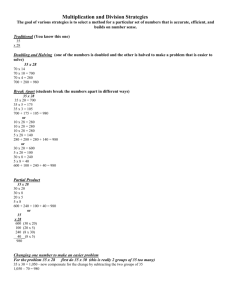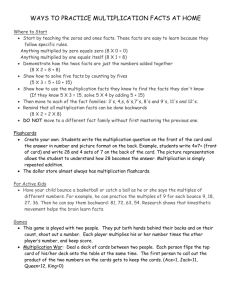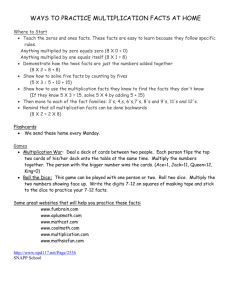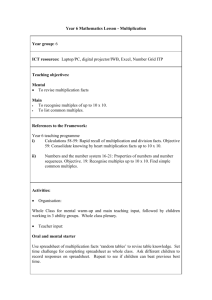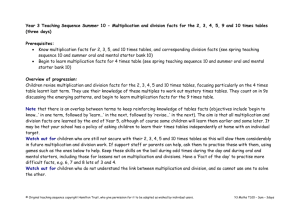Year 2 Teaching Sequence xxx
advertisement
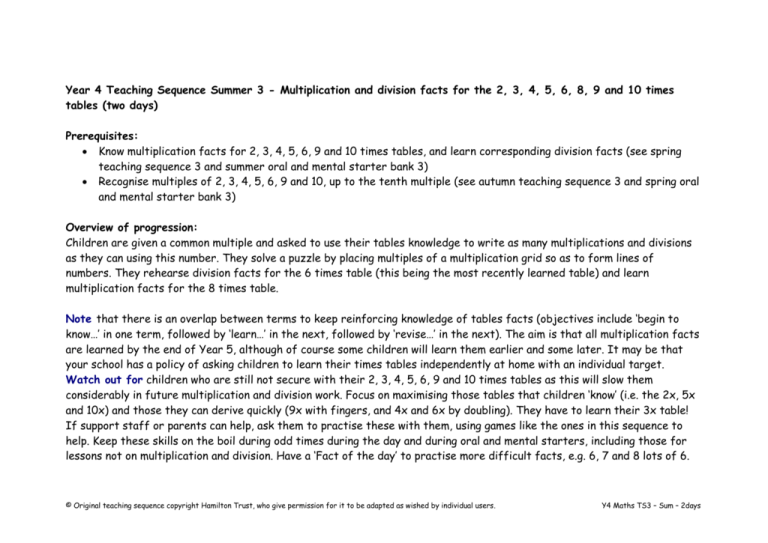
Year 4 Teaching Sequence Summer 3 - Multiplication and division facts for the 2, 3, 4, 5, 6, 8, 9 and 10 times tables (two days) Prerequisites: Know multiplication facts for 2, 3, 4, 5, 6, 9 and 10 times tables, and learn corresponding division facts (see spring teaching sequence 3 and summer oral and mental starter bank 3) Recognise multiples of 2, 3, 4, 5, 6, 9 and 10, up to the tenth multiple (see autumn teaching sequence 3 and spring oral and mental starter bank 3) Overview of progression: Children are given a common multiple and asked to use their tables knowledge to write as many multiplications and divisions as they can using this number. They solve a puzzle by placing multiples of a multiplication grid so as to form lines of numbers. They rehearse division facts for the 6 times table (this being the most recently learned table) and learn multiplication facts for the 8 times table. Note that there is an overlap between terms to keep reinforcing knowledge of tables facts (objectives include ‘begin to know…’ in one term, followed by ‘learn…’ in the next, followed by ‘revise…’ in the next). The aim is that all multiplication facts are learned by the end of Year 5, although of course some children will learn them earlier and some later. It may be that your school has a policy of asking children to learn their times tables independently at home with an individual target. Watch out for children who are still not secure with their 2, 3, 4, 5, 6, 9 and 10 times tables as this will slow them considerably in future multiplication and division work. Focus on maximising those tables that children ‘know’ (i.e. the 2x, 5x and 10x) and those they can derive quickly (9x with fingers, and 4x and 6x by doubling). They have to learn their 3x table! If support staff or parents can help, ask them to practise these with them, using games like the ones in this sequence to help. Keep these skills on the boil during odd times during the day and during oral and mental starters, including those for lessons not on multiplication and division. Have a ‘Fact of the day’ to practise more difficult facts, e.g. 6, 7 and 8 lots of 6. © Original teaching sequence copyright Hamilton Trust, who give permission for it to be adapted as wished by individual users. Y4 Maths TS3 – Sum – 2days Objectives: Revise multiplication facts for 2, 3, 4, 5, 6, 9 and 10 times tables, and learn corresponding division facts Begin to learn multiplication facts for the 8 times table Look at patterns, investigate general statements Whole class Group activities Paired/indiv practice Remind chn how we can revise our times tables facts: The 2x, 5x and 10x tables we know from our infant days! The 9x table we can do on our fingers and all multiples of 9 have digits which add to 9 We need to learn by heart our 3x table! We can double the 2x table to get the 4x, we can double the 3x table to get the 6x Point out that we have to learn, memorise and completely remember the 3x table. Rehearse this with the class by chanting it! Write the number 24 on the board. Work with a partner to write as many multiplications with this as an answer and divisions starting with this number as you can on your whiteboards. Take feedback: 8 × 3 = 24, 3 × 8 = 24, 2 × 12 = 24, 12 × 2 = 24, 24 ÷ 3 = 8, 24 ÷ 8 = 3, 24 ÷ 2 = 12, 24 ÷ 12 = 2. Repeat with 20, 40 and 48. Launch the Number grid ITP and use the toggle to highlight multiples of 8. What pattern do you notice? Talk to your partner. Take feedback and discuss how each number is two before the number below the previous Group of 4-5 children Ask children to sketch a 3 by 2 grid on their boards and choose six numbers from 1 to 10 to write in it, one in each section. Call out questions such as: How many 6s are in 18? How many 6s are in 54? If children aren’t sure, remind them how they can count up in 6s, keeping track on their fingers. Children ring the answer if they have it; the first to ring all six numbers wins. Easier: First, count up in 6s recording the multiples on an ENL jotting on the flipchart. Hide this as you ask each question, then reveal for children to check. Children are given certain multiples to place on a grid. For some (e.g. 20) there will be several positions where they could place them. They try and place them so that they make as many lines of four as possible. Easier: Children write the numbers in as many places as possible on the grid. Activity sheet of grid and numbers Scissors and glue sticks Group of 4-5 children Ask children to record the multiplication facts for the 4 times table, and by the side the 8 times table. What do you notice? Draw out how can Give each pair a 1-10 dice. Children roll the dice and draw that number of hops of 8 on an ENL and write the corresponding multiplication. ITP Number grid Post-its™ Counting stick 1-10 dice © Original teaching sequence copyright Hamilton Trust, who give permission for it to be adapted as wished by individual users. Resources Y4 Maths TS3 – Sum – 2days multiple of 8 as we can add 8 by adding 10 and subtracting 2. Also draw out that the numbers end in 0, 2, 4, 6, or 8. What does that tell us about the multiple of 8? Why doesn’t that surprise you? Write 8, 18, 24… 80 on Post-its™ and attach these to the counting stick. Count along the counting stick. Repeat after removing 8, 24, 48 and 72. Point to where 24 should be. What number goes here? How can you work it out? Point to 48 and repeat. Ask multiplication questions such as: What are five 8s? Four 6s? How did you work this out? Remember that five 8s will give the same answer as eight 5s! Five 8s is also half of ten 8s. We can use our other tables facts to help us work out multiples of 8, and as we haven’t learned our 7 times tables yet, seven 8s is perhaps the hardest fact to learn. But there is a trick to help us! Write 56 = 7 × 8 on the board. Look 5, 6, 7 8! we can double the four times table to get the facts for the eight times table. Why do you think this is? So if you struggle to remember what six 8s are, double six 4s! How could we use what we have here to get the 12 times table? Ask children to add the multiples of 4 and 8 to make multiples of 12. Easier: Just list multiples of 4 and 8. Harder: Also generate the 16 times table. When they have all the possible multiplications, they turn the ENL over, and sketch a 3 by 2 grid on their boards and choose six multiples of 8 to write on it. Working in pairs, they roll the dice, work out that number of 8s, and ring the answer if they have it. They turn the ENL over to check. The first one to ring all six numbers wins. Harder: When children record hops of 8, they record both the multiplication and division facts. © Original teaching sequence copyright Hamilton Trust, who give permission for it to be adapted as wished by individual users. Y4 Maths TS3 – Sum – 2days
